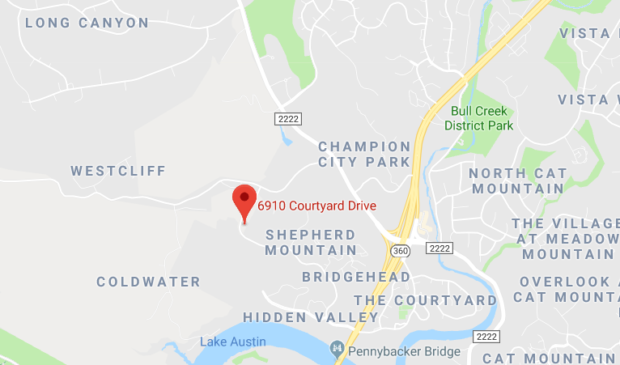Citing density concerns, West Austin lot receives recommendation for subdivision
Tuesday, February 12, 2019 by
Jessi Devenyns After purchasing his home in May 2016 under the assumption that the city would permit him to subdivide his 3.2-acre lot into two 1.6-acre lots, Rick Engel, the owner of Ski Shores restaurant, found himself still pleading his case almost three years later.
His lot, which sits at 6910 West Courtyard Drive, is a long property that is crosshatched by slopes of varying grades, most of which are above 15 percent. That means, in order to construct a driveway, he requires a variance. The property’s undulating elevations, while a hallmark of the Texas Hill Country, conflict with city code which says a driveway cannot be built on grades steeper than 15 percent unless it is to access at least two contiguous acres with a gradient of 15 percent or less or a building site with at least five residential units.
As Engel is only intending to build one other structure on the property, he found himself before the Environmental Commission at its Feb. 6 meeting asking for a variance that would allow him to construct a driveway on the hilly terrain.
Christopher Bradford, a real estate attorney with Jackson Walker, told the commission that the design of the driveway was configured in order to reduce the length of the driveway and therefore its impervious cover. He did acknowledge that there was technically a way to construct a driveway without asking for a variance but said, “You’d have to walk 200 feet to get from your door to your car,” which he said was not ideal.
Commissioner Wendy Gordon noted that requesting driveway variances in West Austin is a common practice because “otherwise we’d have no housing in West Austin.” She added that even her own driveway required a variance.
Still, Development Services staffer Pamela Abee-Taulli expressed her concern that granting the variance would set an unwelcome precedent for future cases. “We’re seeing a lot of attempts to develop lots that were previously considered undevelopable due to price pressures,” she said.
Commissioners agreed that housing price is a valid concern in Austin, but some were unsure whether that argument held as much water outside of the urban core where the city is encouraging density.
“I would be more sympathetic if it was a more urban place,” said Commissioner Katie Coyne, who explained that closer into the city it was possible to track a “net benefit and public good” as a result of increased density.
Similarly, Commissioner Peggy Maceo cautioned that there was money to be made on land throughout Austin, and therefore the commission needed to balance development interests and the city’s interest in density.
On the other side of the dais, Gordon argued that the Courtyard Drive neighborhood isn’t exactly out in the “wilderness.” She noted that similar to downtown, business parks and offices are appearing all along Ranch to Market Road 2222 and Highway 360, but if people can’t live in the area because the neighborhoods cannot accommodate any more lots, there will be a similar housing issue to what is occurring in the urban core.
Despite trepidation about passing this variance and the effects it will have down the line, the Environmental Commission recommended approval with a 6-4 vote. Commissioners Coyne, Maceo, Mary Ann Neely and Linda Guerrero voted against the motion.
Map courtesy of Google Maps.
The Austin Monitor’s work is made possible by donations from the community. Though our reporting covers donors from time to time, we are careful to keep business and editorial efforts separate while maintaining transparency. A complete list of donors is available here, and our code of ethics is explained here.
You're a community leader
And we’re honored you look to us for serious, in-depth news. You know a strong community needs local and dedicated watchdog reporting. We’re here for you and that won’t change. Now will you take the powerful next step and support our nonprofit news organization?











